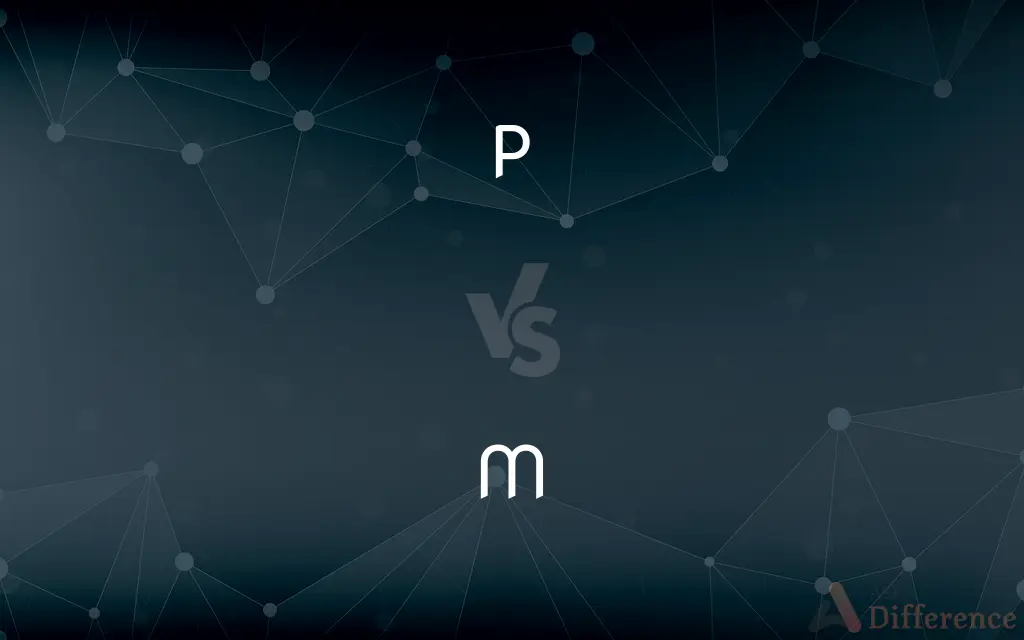P vs. M — What's the Difference?
Edited by Tayyaba Rehman — By Fiza Rafique — Updated on April 3, 2024
"P" typically refers to phosphorus, a reactive nonmetal used in fertilizers and fireworks, while "M" often signifies molybdenum, a metal used to strengthen steel and in chemical applications.

Difference Between P and M
Table of Contents
ADVERTISEMENT
Key Differences
Phosphorus, symbolized as "P", is a key element in DNA, RNA, and ATP, fundamental to life's biochemical processes. Molybdenum, denoted as "M" in certain contexts (though its chemical symbol is Mo), is crucial in enzymes for nitrogen fixation and sulfur metabolism in living organisms. While phosphorus is essential for energy transfer and genetic information storage, molybdenum's role is more specialized in enzyme function.
In industrial applications, phosphorus is widely used in the production of fertilizers, detergents, and fireworks, exploiting its reactivity and energy release upon combustion. On the other hand, molybdenum serves as an alloying agent in steel to enhance its strength and resistance to corrosion, illustrating the contrast in their commercial uses based on their chemical properties.
Phosphorus exists in several allotropic forms, including white, red, and black phosphorus, each with unique properties and applications. Molybdenum, however, is mostly used in its metallic form or as a compound in catalysts, displaying less allotropic variety but significant versatility in industrial and chemical processes.
Environmental concerns regarding phosphorus primarily focus on its role in water pollution and eutrophication, where excessive fertilizer use leads to harmful algal blooms. Molybdenum, while less commonly discussed in environmental contexts, can be toxic in high concentrations, especially in water systems, highlighting different environmental impacts associated with each element.
The discovery of phosphorus in 1669 by alchemist Hennig Brand from urine marked it as the first element discovered that was not known since ancient times, showcasing a fascinating history of scientific discovery. Molybdenum's identification in 1778 by Carl Wilhelm Scheele and later isolation by Peter Jacob Hjelm in 1781 reflect the progressive uncovering of elements through mineral studies, underscoring the diverse paths to discovering these fundamental building blocks of matter.
ADVERTISEMENT
Comparison Chart
Symbol/Notation
P
Mo (often abbreviated as "M")
Role in Biology
Vital for DNA, RNA, ATP
Important for enzymes in nitrogen and sulfur cycles
Industrial Use
Fertilizers, detergents, fireworks
Steel strengthening, chemical catalysts
Allotropic Forms
White, red, black phosphorus
Mostly used in metallic form
Environmental Impact
Water pollution, eutrophication
Toxicity in high concentrations
Discovery
1669 by Hennig Brand
1778 by Carl Wilhelm Scheele
Physical State
Nonmetal
Metal
Reactivity
Highly reactive
Relatively stable, but reactive in certain forms
Commercial Use
Broad, in various compounds
Specific, mainly in alloys and catalysts
Compare with Definitions
P
Component of fertilizers.
Phosphorus promotes root development in plants.
M
Found in some electronics.
Molybdenum is used in thin films for transistors.
P
Causes environmental concerns.
Runoff containing phosphorus can lead to water eutrophication.
M
Important for certain enzymes.
Molybdenum is a cofactor in enzymes that fix atmospheric nitrogen.
P
A nonmetal essential for life.
Phosphorus is crucial in forming DNA and bones.
M
A metal that strengthens steel.
Molybdenum alloys are used in aerospace applications.
P
Reactive and shows allotropy.
White phosphorus must be stored under water to prevent it from igniting.
M
Less reactive than phosphorus.
Molybdenum does not spontaneously ignite in air.
P
Used in safety matches.
Red phosphorus is found on the striking surface of matchboxes.
M
Can be toxic in large amounts.
High levels of molybdenum can be harmful to livestock.
P
P, or p, is the sixteenth letter of the modern English alphabet and the ISO basic Latin alphabet. Its name in English is pee (pronounced ), plural pees.
M
M, or m, is the thirteenth letter of the modern English alphabet and the ISO basic Latin alphabet. Its name in English is em (pronounced ), plural ems.
P
The 16th letter of the modern English alphabet.
M
The 13th letter of the modern English alphabet.
P
Any of the speech sounds represented by the letter p.
M
Any of the speech sounds represented by the letter m.
P
The 16th in a series.
M
The 13th in a series.
P
Something shaped like the letter P.
M
Something shaped like the letter M.
P
P A hypothesized textual source of certain portions of the Pentateuch that have a formulaic style, contain genealogical lists and descriptions of rituals, and use the name "Elohim" to refer to God.
M
(grammar) masculine
P
Abbr of postmeaning after
M
Abbreviation of meter
P
Abbreviation of per
M
Abbreviation of mile
P
(stenoscript) up
M
Abbreviation of month
P
Alternative form of|en|p.}}; {{abbr of page(plural pp)
M
Abbreviation of minute
P
(UK) penny; pence
M
Abbreviation of million
P
(physics) proton
M
Abbreviation of minim
P
(video compression) progressive scan
M
(music) measure
P
Abbr of pee
I'll slurp all that p.
M
(obsolete) thousand
P
(knitting) purl
M
(knitting) make
P
(Internet) pretty
I'm doing p good, how are you?
M
M, the thirteenth letter of the English alphabet, is a vocal consonant, and from the manner of its formation, is called the labio-nasal consonant. See Guide to Pronunciation, 178-180, 242.
P
Alternative spelling of p.m.
M
As a numeral, M stands for one thousand, both in English and Latin.
P
The sixteenth letter of the English alphabet, is a nonvocal consonant whose form and value come from the Latin, into which language the letter was brought, through the ancient Greek, from the Phœnician, its probable origin being Egyptian. Etymologically P is most closely related to b, f, and v; as hobble, hopple; father, paternal; recipient, receive. See B, F, and M.
M
A quadrat, the face or top of which is a perfect square; also, the size of such a square in any given size of type, used as the unit of measurement for that type: 500 m's of pica would be a piece of matter whose length and breadth in pica m's multiplied together produce that number.
P
A multivalent nonmetallic element of the nitrogen family that occurs commonly in inorganic phosphate rocks and as organic phosphates in all living cells; is highly reactive and occurs in several allotropic forms
M
A brand or stigma, having the shape of an M, formerly impressed on one convicted of manslaughter and admitted to the benefit of clergy.
P
The 16th letter of the Roman alphabet
M
The basic unit of length adopted under the Systeme International d'Unites (approximately 1.094 yards)
M
Concentration measured by the number of moles of solute per liter of solvent
M
The cardinal number that is the product of 10 and 100
M
The 13th letter of the Roman alphabet
M
Denoting a quantity consisting of 1,000 items or units
Common Curiosities
Can excessive phosphorus in water be harmful?
Yes, it can lead to eutrophication and harmful algal blooms.
What is the primary biological role of phosphorus?
Phosphorus is essential for the formation of DNA, RNA, and ATP in living organisms.
What industries benefit most from molybdenum?
The steel and chemical industries benefit significantly from molybdenum's properties.
How does molybdenum contribute to steel's properties?
Molybdenum enhances steel's strength and corrosion resistance.
Are phosphorus and molybdenum naturally occurring elements?
Yes, both elements occur naturally in various mineral compounds.
How was phosphorus discovered?
By distilling concentrated urine and heating its residue under exclusion of air.
What forms of phosphorus are most commonly used?
Red and white phosphorus are commonly used, each in specific applications like matches and military incendiaries.
Is molybdenum essential for human health?
Yes, it's a trace element necessary for the function of certain enzymes.
What are the environmental impacts of mining for molybdenum?
Mining can lead to habitat destruction and water pollution.
How does molybdenum toxicity manifest in living organisms?
Through impaired copper absorption, leading to various health issues.
Can phosphorus be toxic?
Yes, white phosphorus is highly toxic and can cause severe burns upon contact with skin.
Why is molybdenum considered less reactive than phosphorus?
Due to its metallic nature and stable electron configuration, making it less prone to rapid oxidation.
What measures can mitigate phosphorus-induced eutrophication?
Reducing fertilizer runoff and using phosphorus-free detergents can help.
What are some common compounds containing phosphorus?
Phosphates used in fertilizers and detergents are widespread.
Share Your Discovery

Previous Comparison
Jingle vs. Rhyme
Next Comparison
Duration vs. TimelineAuthor Spotlight
Written by
Fiza RafiqueFiza Rafique is a skilled content writer at AskDifference.com, where she meticulously refines and enhances written pieces. Drawing from her vast editorial expertise, Fiza ensures clarity, accuracy, and precision in every article. Passionate about language, she continually seeks to elevate the quality of content for readers worldwide.
Edited by
Tayyaba RehmanTayyaba Rehman is a distinguished writer, currently serving as a primary contributor to askdifference.com. As a researcher in semantics and etymology, Tayyaba's passion for the complexity of languages and their distinctions has found a perfect home on the platform. Tayyaba delves into the intricacies of language, distinguishing between commonly confused words and phrases, thereby providing clarity for readers worldwide.
















































